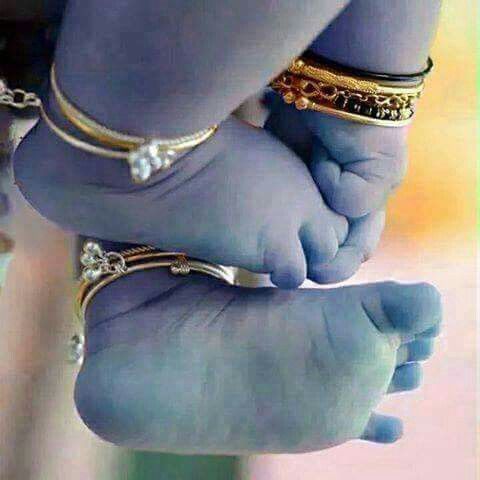
नाम्यते अभिधीयते अर्थोऽनेन इति नाम
that whose meaning encompasses the characteristics of a person, is a name.
Namakarana is a very important samskara in Sanatana Dharma. A person’s personality is seen through the eyes, but is heard and understood through the name. A person or thing’s first experience is usually had through the eyes, and it’s understanding or interpretation is usually though the name.
And this is why in our culture, a name is not arbitrarily assigned. In fact, it is only decided upon after the baby is born. Parents and elders take 11-14 days to observe the characteristics of the baby, it’s tendencies and gunas (sattva, rajas and tamas) and then after careful consideration, the names are assigned.
I said names. Because, one name cannot define everything about a person. The greater the personality, the more names they have. This is why we have the Vishnu Sahasranama – even one thousand names are not enough to define the universal consciousness.
For us mortals, 4-5 names are usually assigned.
In Sanatana Dharma, there are four prominent names – मासनाम्न, नक्षत्रनाम्ना, व्यवहारिकनाम्नाच संस्करिष्ये – Vyavahārika nama, māsa nama, Nakshatra nāma, and kula nama.
The name by which the baby will be addressed by the world at large, the legal name – is called Vyavahārika nama. Everyone wants a unique name for their baby, but one has to be careful here. Going to baby names.com type of websites does not help much, and given that this is a name that your child will live with his or her whole life, you should put more effort into arriving at a suitable name.
If you are looking for a name in Sanskrit, Vishnu and Shiva Sahasranāmas for boys and Lalita Sahasranāma for girls are easier default options – you cannot go wrong with over a thousand options, duly vetted by thousands of years of usage.
If you are looking for something unique, then again Sanskrit can have the answers. Remember, there is no concept of a dictionary in Sanskrit, given that words are made from basic building blocks, or Dhatus. You can make just about any number of word combinations, and new words as well. Just get this checked from a few scholars before finalising though.
As per Shāstras,
The last letter should be prolonged (dirgha) or should have the visarga. The less prolonged letters (rhasva) are predominant in Energy (Shakti) while the more prolonged (dirgha) ones or those containing visarga are predominant in Shiv (Brahman). Since the motive in Spirituality is union with the Shiv principle, this rule is followed.
A boy’s name should consist of two or four aksharas, while a girl’s should consist of an odd number of letters that is 3, 5 or 7. Letters in odd numbers predominate in Energy (Shakti) while those in even numbers are Shiv predominant.
Next is the name based on the family deity or kula devta. This is kula nama. Having the child named after your kula devta or devi, brings one closer to the object of your bhakti, your devotion. After all, you do call your child quite a few times a day isn’t it? And with a lot of love…
The masa nama is based on the lunar month of birth – कृष्णोऽनन्तोऽच्युतश्चक्री वैकुण्ठोऽथ जनार्दनः ।उपेन्द्रो यज्ञपुरुषो वासुदेवस्तथा हरिः ।योगीशः पुण्डरीकाक्षो मासनामान्यनुक्रमात् ॥ – you can use this quick guide (starting from the चैत्र – Chaitra māsa).
Nakshatra nama is based on the Nakshatra – and hence dependent on the time of birth. Elaborating on the calculation is a bit beyond what I want to convey here, but you can get in touch with me in case you want more details. This nāma is usually the main nāma, along with the vyavahārika nama.
I know what some of you may be thinking, In today’s world, is it practical to keep so many names? Isn’t it confusing?
Our ancestors were quite advanced in their thinking. We may have the best tech at our disposal nowadays, but it does not come close to the technology that they left behind for us. Every aspect of life was dissected, every moment was thought upon, and remedies and solutions were made available for just about any physical, mental or emotional ailment known, or unknown to man at that time.
For instance, the janma tithi that I spoke about in an earlier article. Or of course, the whole science of yoga and Ayurveda that everyone is rediscovering today.
My point being, a lot of thought went into devising such methods for the naming of a child. Some may not seem logical, but seeing the world through a pure filter of logic will put a lot of our relationships and even our existence, into question. Ask any classical physicist what he thinks about quantum physics and you will enjoy the response. But it is this very “illogical” quantum physics that drives all our tech today, including the computer that I am typing this article on, and the mobile that you are reading this article on.
And so, sometimes it’s good to leave that filter aside and just accept. If you cannot spend time and effort in naming your own newborn, if you cannot work with 4-5 different names that bring out various aspects of your child, if your excuse is modernity…then well, each to his own.
But in my opinion, you may be missing out on a very interesting and important facet of your life, one that can be intriguing and awe-inspiring, at the same time.
to be continued…
